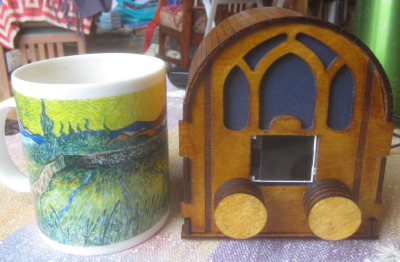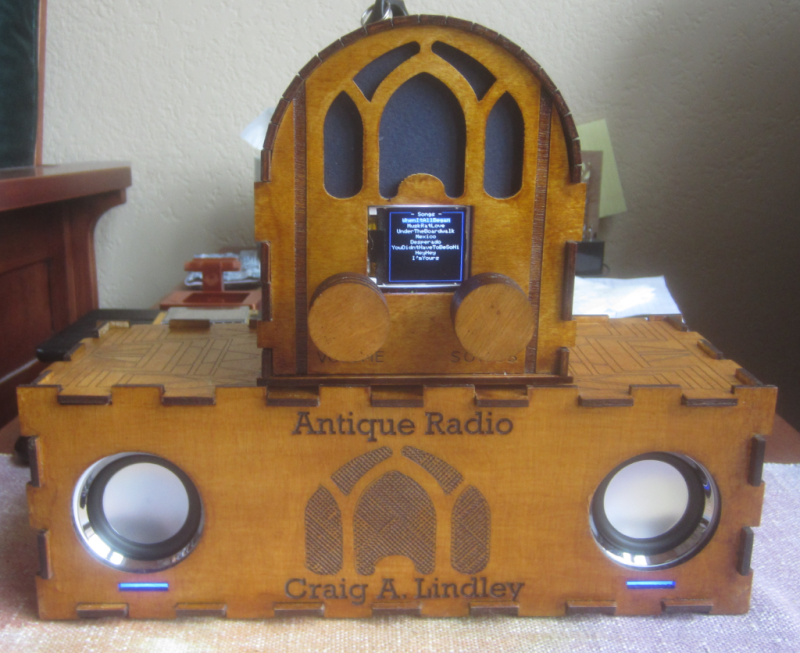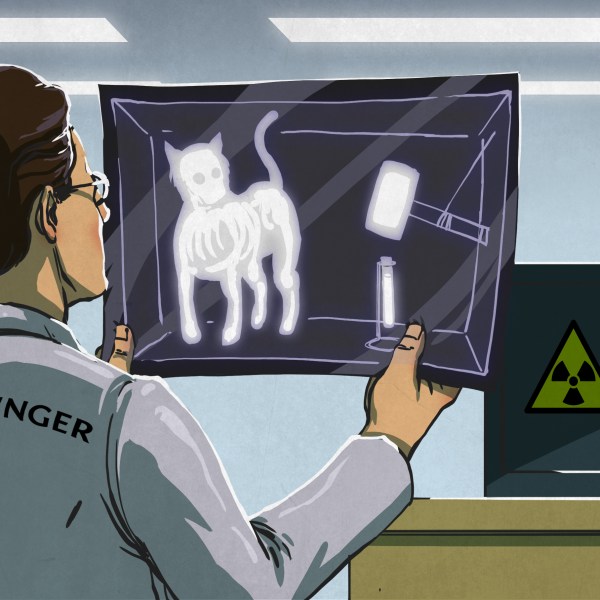This beautiful little radio may look like an art deco relic from a hundred years ago, but it is actually from 2023. When [Craig Lindley] first saw this design on these very pages a few years ago, he just had to build one eventually. Turns out, all he had to do wait until he bought a laser cutter.
 Built with hardware on hand, this radio runs on an ESP32 WROOM and uses an Adafruit VS1053 CODEC breakout. Song information is displayed on an SPI LCD display, and output comes via a 1/8″ jack. It can play songs streamed from Internet radio stations, [Craig]’s website, or directly from an SD card.
Built with hardware on hand, this radio runs on an ESP32 WROOM and uses an Adafruit VS1053 CODEC breakout. Song information is displayed on an SPI LCD display, and output comes via a 1/8″ jack. It can play songs streamed from Internet radio stations, [Craig]’s website, or directly from an SD card.
The lovely cabinet is made from 1/8″ Baltic birch, with a living hinge for a roof and sides. The amber shellac goes a long way toward establishing the antique aesthetic.
Not content with this cute radio, [Craig] went ahead and built a speaker system to go with it out of a pair of small, external laptop speakers. [Craig] says this project had a lot of ups and downs, but we are quite happy to see it come to fruition.
Do you have an antique radio you’d like to restore? Be sure to check out our guide.

















Well, I would easily guess that it isn’t from a 100 years ago, namely blue LEDs, color LCDs and CNC laser cutters were much scarcer back then.
That may be so, but the design still has some nice appeal.
I like how the blue LED complements the blue line on the display. Although some piece of dark glass in front of the display in combination with a small (also lasercut) bezel might improve the looks a lot. The currently gaping hole in the center of the overall very pretty cabinet does distract enormously from a project very nicely done. Very fun project and a nice example of what a lasercutter in the right hands can do.
The design seems to be based on the, uhm, “cathedral” type of vintage radios.
It apparently was a thing at the time, not sure why.
Like this one:
https://www.stonevintageradio.com/description.php?II=284&UID=20231122115642
But there also were elegant and serious radios early on (non kitschy).
https://www.stonevintageradio.com/description.php?II=819&UID=20231122120140
Especially the early detector crystal radios were pieces of art.
Polished wood, hand wound coils, variometer coils..
I could go on, but that would be nsfw. 🤣
“It apparently was a thing at the time, not sure why”.
It sure would reduce the possibility of me seeing it as another flat surface to pile stuff on top of.
“It sure would reduce the possibility of me seeing it as another flat surface to pile stuff on top of. ”
Why would that be a disadvantage?
A flower pot would fit nicely on top of a square or rounded radio.
The TVs and record players weren’t looking like miniature churches or domes, either.
Here’s a tube radio that I find a bit more esthetically pleasing.
https://www.radiomuseum.org/r/braun_kleinsuper_sk2_2.html
It’s a bit newer (50s), but contains the same components, essentially.
It’s not looking like, say, a prop out of a movie about a haunted mansion. It doesn’t have kitschy lion feet or those teeth buttons, either.
The design is a bit minimalistic (could be nicer, could have a magic eye), but has its charme. Like a VW Beetle, maybe.
A flower pot on top of a radio in a wooden housing with high voltage inside sounds like a recipe for disaster. If nothing worse happens, the water from the flower pot will ruin the wood in short order.
I’ve never understood the hatred for “Gebiss” radios. Have all you folks got some kind of shared traumatic experience? Did your evil nannies connect your little footsies to the high voltage speaker signal and torture you with electric shocks to the beat of Freddy Quin’s greatest hits?
They had to be that shape because the bottom was for the electronics, including a transformer or two for the tubes, which left the top for the speaker. https://antiqueradio.org/art/Philco90Back.jpg
Need a bezel on that display, seems an oft forgotten detail.
I own a half dozen actual antique radios, I’ve seen dozens more in person (many beyond repair), and I’ve seen pictures of hundreds of them. That radio is by far the ugliest I’ve ever seen.
I heartily agree with you. It might have a place under a plastic xmas tree, though !
It never ceases to amaze me to see how supportive people can be in the comments here.
I prefer honesty.
You must be real fun at parties.
As an antique radio guy, I’m not terribly impressed. A better idea (and one I’ve seen done and have done myself) is to get an old radio in/to functional condition, build a small AM transmitter that’s jacked into an audio source (Alexa, raspi, etc.) then tune the radio into the transmitter’s signal. I have an Echo that
is playing “Yours Truly, Johnny Dollar” on the beautiful old 1940 Philco console in my living room as I type this.
If you’re fine with a hack, one of the cheapest ways to do this is to grab one of those little 4-pin crystal oscillators in a can, and “modulate” the supply voltage with an audio signal to get a weak but listenable output. Just don’t let it radiate much, put it very close to the receiver instead, because it’s a squarish not very great output. If your antique radio has good sound, maybe use a better transmitter too. Or give the osc a constant supply, and modulate the output with a spare tube or by winding a small magnetic amplifier for your chosen frequency. I did the latter for fun once, it wasn’t great either but was different.
A little more design thought and you could have a much nicer look. Add a cloth behind the top cutouts, make the knobs 2/3 smaller and make the cutout for the ‘dial’ fit the visual display screen better, maybe with a bezel as another commenter suggested.
Go look up the Chronotune radio, similar design but very different execution…